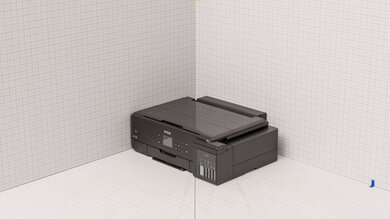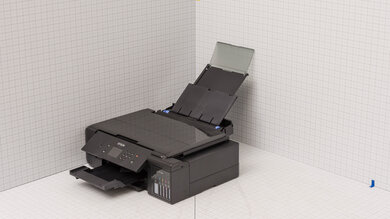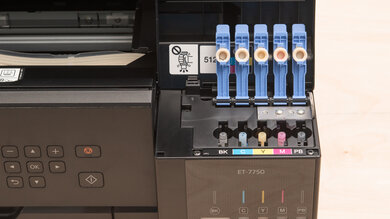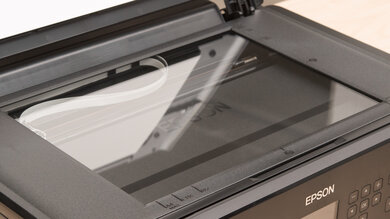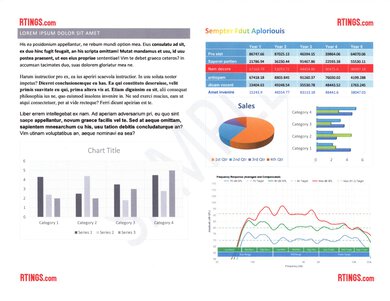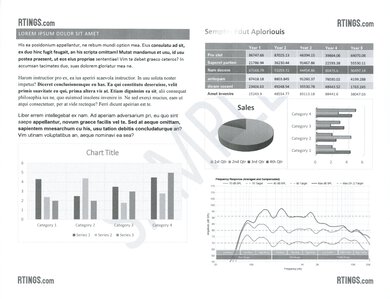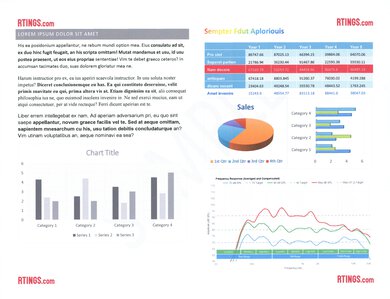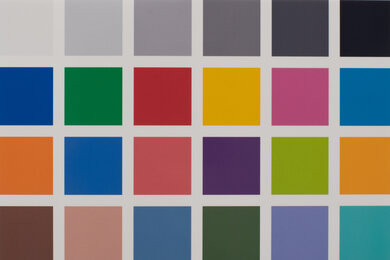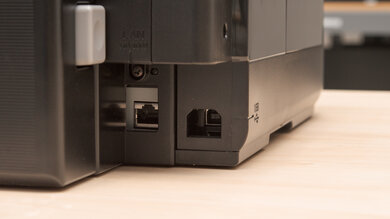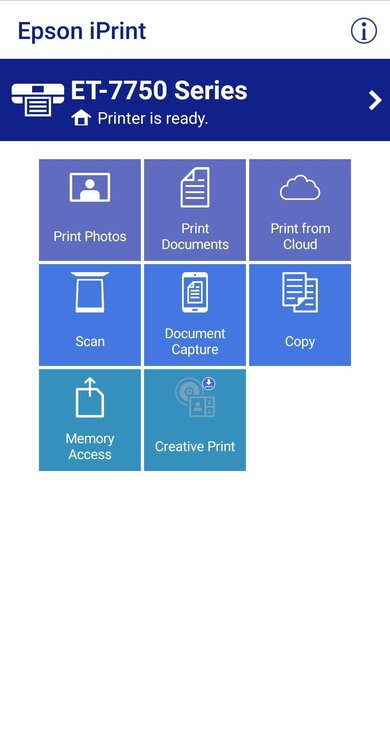The Epson EcoTank ET-4850 is an all-in-one inkjet printer. It has a refillable ink tank instead of ink cartridges and uses Epson's T502 ink. It has a 250-sheet input tray and supports automatic duplex printing. The scanner has an automatic feeder but doesn't support duplex scanning. Its connectivity options include USB, Wi-Fi, and Ethernet, and it also supports Apple AirPrint and Mopria Print Service.
Our Verdict
The Epson EcoTank ET-4850 is great for family use. It has plenty of connectivity options, including Wi-Fi and USB, so it's easy for every household member to access. It produces sharp documents, prints reasonably quickly, and doesn't cost much to maintain due to its high page yields and cheap ink. It isn't a bad choice for photo printing either; it can reproduce a wide range of colors and does a good job of rendering very fine details, though it tends to oversaturate some colors, and the pictures also look a tad grainy. The scanner has an automatic feeder, although it only processes up to five pages per minute and doesn't support duplex scanning.
-
Produces high-quality documents.
-
Exceptional page yields; low running costs.
-
Produces detailed and colorful photos.
-
Low maintenance.
-
Wide connectivity options and mobile app support.
-
Poor color accuracy.
-
Photos look slightly grainy.
The Epson EcoTank ET-4850 is great for small or home offices. It produces high-quality documents and doesn't require much maintenance, thanks to its exceptionally high page yields. Its overall printing speed is okay; it's reasonably fast with black-and-white documents; however, it's slow with color documents, and it takes a while to wake from an idle state. Unfortunately, although the scanner has an automatic feeder and produces very detailed scans, it doesn't support duplex scanning.
-
Produces high-quality documents.
-
Exceptional page yields; low running costs.
-
Low maintenance.
-
Sturdy build and easy access to paper jams.
-
No duplex scanning.
-
Slow to wake from an idle state.
The Epson ET-4850 is excellent for student use. It produces sharp documents, and thanks to its high page yields, it doesn't cost much to maintain. It prints reasonably fast but is a little slow to initialize and get a single page out. You can connect to the printer via USB, Wi-Fi, or Ethernet, and there's also support for Apple AirPrint and Mopria Print Service, making it easy to print from various devices. The scanner has an automatic feeder and extendable lid hinges. However, it doesn't support duplex scanning.
-
Produces high-quality documents.
-
Exceptional page yields; low running costs.
-
Low maintenance.
-
Wide connectivity options and mobile app support.
-
Slow to wake from an idle state.
The Epson ET-4850 is great for printing black-and-white documents. It produces sharp documents, and its ink tank yields thousands of pages, making it a great choice for high-volume printing. Although it's a little slow to wake from an idle state, it prints reasonably quickly once it gets going and supports automatic duplex printing, so you don't need to flip the pages manually when printing double-sided sheets. Its scanner produces outstanding scans; however, it only processes up to five pages per minute and doesn't support duplex scanning.
-
Produces high-quality documents.
-
Exceptional page yields; low running costs.
-
Low maintenance.
-
Sturdy build and easy access to paper jams.
-
No duplex scanning.
-
Slow to wake from an idle state.
The Epson ET-4850 is good for photo printing. It can reproduce a wide range of colors and very fine details in photos. However, its color accuracy isn't great, as it tends to oversaturate some colors like blues and greens, and color transitions look grainy. As for its cost per print, its ink tank yields thousands of prints, so you won't have to worry about high maintenance costs, even if you print a lot.
-
Exceptional page yields; low running costs.
-
Produces detailed and colorful photos.
-
Low maintenance.
-
Sturdy build and easy access to paper jams.
-
Poor color accuracy.
-
Photos look slightly grainy.
-
Exceptional page yields; low running costs.
-
Low maintenance.
-
Exceptional page yields; low running costs.
-
Low maintenance.
-
Exceptional page yields; low running costs.
-
Low maintenance.
-
Exceptional page yields; low running costs.
-
Low maintenance.
-
Exceptional page yields; low running costs.
-
Low maintenance.
- Family
- Small/Home Office
- Student
- Black & White
- Photo
Performance Usages
- Color Quality
- Document Quality
- Scanner
- Speed
- Recurring Costs
- Updated May 03, 2024: Added mention of the Lexmark MC3462i as an alternative with faster scan speed and duplex scanning in the Scanner Features section.
- Updated Mar 01, 2024: We've made slight adjustments to the text of the review to better convey product details.
- Updated Jun 14, 2023: Added link to the HP Smart Tank 7301 in the 'Printing Speed' section to provide an alternative that takes less time to warm up.
- Updated Mar 09, 2023: Review published.
- Updated Mar 02, 2023: Early access published.
- Updated Feb 27, 2023: Our testers have started testing this product.
- Updated Feb 23, 2023: The product has arrived in our lab, and our testers will start evaluating it soon.
- Updated Feb 15, 2023: We've purchased the product and are waiting for it to arrive in our lab.
Differences Between Sizes And Variants
We tested the Epson EcoTank ET-4850. It's also sold as the Epson EcoTank ET-4856 in some European countries. Our review applies to both models.
| Model | Notes |
|---|---|
| Epson EcoTank ET-4850 | - |
| Epson EcoTank ET-4850 Special Edition | Includes an additional bottle of black ink |
| Epson EcoTank ET-4856 | European model |
You can see our unit's label here.
Compared To Other Printers
The Epson ET-4850 is a great printer overall. It stands out for its high page yields and wide color gamut. However, you can easily find cheaper models that perform just as well.
For more options, see our recommendations for the best printers, the best inkjet printers, and the best printers with cheap ink.
The Epson EcoTank ET-4850 is almost identical to the Epson EcoTank ET-3850. The only difference is that the ET-4850 has a touch-sensitive display and a dampener to prevent the scanner bed from slamming shut.
The Epson EcoTank ET-4850 is much better than the Epson EcoTank ET-2850 for most uses. The ET-4850 has a sturdier build and a better display. It also has an automatic feeder and Ethernet connectivity, both of which the ET-2850 lacks. The ET-4850 produces higher-quality black-and-white documents and scans, prints faster, and yields slightly more pages.
The Epson EcoTank ET-4850 is better than the Epson EcoTank ET-4800 for most uses. The ET-4850's build feels sturdier, and its design is more user-friendly, as it allows for easier access to the sheet rollers. It also produces higher-quality black-and-white documents, prints faster, and yields significantly more pages. The ET-4850 has a slightly wider color range; however, the ET-4800 reproduces colors more accurately, and it brings out more details in photos.
The Epson EcoTank Pro ET-5180 and EcoTank ET-4850 are all-in-one supertank printers. Although both printers perform similarly, the ET-5180 comes with a wider range of features intended for office use, like duplex scanning and fax functionality. The only other notable difference is that its scanner can process more pages per minute through its ADF.
The Epson EcoTank ET-2800/ET-2803 and the Epson EcoTank ET-4850 are both all-in-one supertank printers, but the ET-4850 performs much better overall. The ET-4850 is more feature-rich, as it has an automatic document feeder and Ethernet connectivity; it also performs better, with higher page yields for both black and color documents, faster printing speeds, and better-quality black and color documents. On the other hand, the ET-2800 produces better-looking photos with more details and better color accuracy.
The HP Smart Tank 7602 and Epson EcoTank ET-4850 are all-in-one super tank printers with similar overall performance. Both offer exceptional cost per print; the 4850 yields a lot more black pages, while the 7620 yields far greater color pages. While neither printer has great color accuracy, photos look significantly better on the Epson due to its superior color gamut. The 7602 allows you to print directly from USB flash drives, offering a convenience that the 4850 lacks.
Although the Epson EcoTank Pro ET-5850 is much better overall than the Epson EcoTank ET-4850, they're two different classes of printers. The ET-5850 is designed for business settings with high print loads, while the ET-4850 is a home-office printer. To this end, the ET-5850 offers more features and better performance; it can dual pass duplex scan at up to 9 pages per minute, print up to 25 black or color pages per minute, and produce sharper color documents. By contrast, the ET-4850 has higher color and black page yields but prints slower at 14 black and seven color pages per minute.
The Epson EcoTank ET-4850 is more versatile than the HP Smart Tank 7301. The Epson is a little more user-friendly in terms of maintenance and has a touch-sensitive screen that displays a wider array of information at a glance. It also produces much sharper scans than the HP, has a wider color gamut, and prints slightly sharper monochrome documents. However, the HP takes much less time to warm up, offers superior color accuracy, and feels better built.
The Epson EcoTank ET-4850 and Epson WorkForce WF-2950 are differently designed inkjet printers, though the ET-4850 does deliver better overall performance in almost every regard. The ET-4850 is a supertank model with a high-capacity ink reservoir that seldom needs filling up, meaning that it has a much greater page yield and incurs lower ownership costs. It also feels better built, has an Ethernet port for connecting to a router, and prints substantially faster.
The Epson EcoTank ET-4850 is better than the Canon PIXMA G6020. The Epson produces higher-quality black-and-white documents, and its wider color range results in more colorful photos. It also prints faster and yields significantly more pages. The Epson has an automatic document feeder, which the Canon lacks, and it produces better scans with more fine details and better color saturation.
Test Results
This printer's build quality is good. Except for the automatic feeder's tray, which feels a little flimsy, the rest of the printer feels very sturdy. The power cable is removable, so it's easy to replace if it gets damaged. The design allows easy access to the ink tanks, sheet rollers, and maintenance box (which collects ink flushed during cleaning). The scanner's lid stays open on its own, and so does the scanner bed. It also has a good dampener to prevent the scanner bed from slamming down.
There are some downsides to the design. First, you can't fully remove the input tray, making it hard to access any paper jammed at the back of the tray. Second, the ADF has a plastic ramp to guide the paper to the scanner bed, which, if scratched (from staples or other things attached to the paper), will cause a permanent line on all scanned sheets, like this sample from the Epson Expression Premium XP-7100.
This printer doesn't require much maintenance. Thanks to its high page yield, you don't need to refill the ink tanks often. Refilling the ink tanks is easy, as each ink bottle has a unique nozzle that can only fit into the corresponding ink tank, although it can still be messy if you aren't careful. The printer doesn't need to be on for the process; opening the ink tank cover automatically triggers the refill function, prompting you to set the ink level.
Two things to remember regarding maintenance: the first is that, like most inkjet printers, the printheads can clog if you don't print for a long time. There are many functions built-in to help resolve clogging and other print quality issues, like printhead cleaning, nozzle check, power cleaning, printhead alignment, and paper guide cleaning. Second, the ink tanks should never be completely empty, as emptying the tanks can introduce air bubbles into the tubes, damaging the printer.
As for paper jams, you can access the sheet rollers through the back panel or by lifting the scanner. You can access the automatic feeder's sheet rollers by lifting the ADF's left cover. The input tray isn't removable, making it hard to remove jammed paper at the back of the tray. The input tray holds 250 sheets of paper, which is fairly spacious, so you likely won't need to refill it regularly unless you print a lot.
You can see the user manual here.
The display is decent. It's easy to see whether you're standing or sitting, and you can also tilt the panel to improve visibility. However, it's hard to see from the side, and its small size makes navigating the user interface challenging for people with large fingers. Touch input feels responsive, and the interface is user-friendly.
The Epson 4850 yields an exceptionally large number of prints, meaning you won't need to refill the tank often. The printer reminds you to check the ink levels whenever you start a print job. It's to ensure the ink tank isn't empty, as it may damage the printer. Another message pops up when the printer thinks the ink levels are low, although it'll continue to print. If the printer thinks the ink level has reached the lower line, it'll stop printing and alert you with this message. At this point, you don't necessarily need to refill the tank if it isn't needed, but you need to set the ink level before you can resume printing. You don't need to fill the tank every time; you can just set the ink level to match what you have in the tank through the settings.
The Epson ET-4850 has decent scanner features. Its ADF is a little slow to process sheets, but it's still more convenient than scanning each page manually. Its OCR (optical character recognition) feature is software-based, so you have to install the Epson Scan 2 or Scan Smart app to use it. The OCR works well; mistakes are usually due to special characters. If you want an alternative with faster scan speeds and duplex scanning, check out the Lexmark MC3426i.
The scan quality is outstanding. Everything looks sharp, and all the finer elements are present. This printer has a main scan resolution is 1200 DPI and a sub-scan resolution of 2400 DPI. The sub-scan resolution is achieved by shifting the carriage, thus increasing the vertical resolution, similar to a camera sensor shift. The scanner can also achieve an interpolated scanning resolution of 9600 DPI.
- Power cord
- User documentation
- Setup CD-ROM
- Epson T502 ink bottles:
- 1x Black
- 1x Cyan
- 1x Magenta
- 1x Yellow
This is a corded printer without a battery.
The print quality of black-and-white documents is outstanding. Text looks clear, and all the fine elements are present. There's some vertical banding; however, they aren't noticeable when printing in portrait orientation. Printing in the 'High-Quality' setting also resolves this issue, even in landscape orientation.
The print quality of color documents is good. Text looks sharp, and colors look sufficiently saturated. Fine elements are present, but they look faint and not as clear as when printing in black and white. There's also some color in the grays, resulting in a purplish tint.
The cost-per-print is remarkably low because a full tank yields a large number of prints, and replacement ink is cheap.

The overall printing speed is okay. It prints black-and-white documents fairly quickly. It's slower with color documents, although most inkjet printers are. It's just slow compared to laser printers. Unfortunately, it takes a while to wake from an idle state, with alternatives like the HP Smart Tank 7301 being able to output pages from an idle state in less time. It also takes a long time to print photos. The Photo Printing Time is the time it takes to print a 4" x 6" photo in the Standard Quality mode. Printing the same photo in the High-Quality mode takes 163 seconds.
The Epson 4850 supports A5 paper, but you need to set a custom size because there isn't a preset for this paper size. You can set a custom paper size between 3.5" × 5" to 8.5" × 87.24" (89 × 127mm to 215.9 × 1200mm).
The Epson ET-4850 has a great color gamut. It can reproduce a wide range of colors, although it struggles with bright, saturated greens, as well as darker shades of greens and yellows. Unfortunately, color transitions look grainy.
The color accuracy is bad; however, printed photos still look natural, as the color inaccuracies are mainly due to oversaturation, especially blues, greens, and browns.
This printer is excellent at reproducing small details. Fine elements look clear; it mainly loses detail in distant objects due to halftones (dot effect).
The Epson 4850 supports various glossy paper sizes up to 8.5" x 11". However, some issues arise when printing borderless or on 4" x 6" paper. The printhead would hit the side of the paper and create a smear, and the paper would shift as soon as it has fully passed through the back sheet rollers, causing misalignment. You can see it in action here. This issue doesn't happen with other paper sizes, and it resolved itself after running a cleaning task. Unfortunately, it's unclear whether this is an isolated incident or one that could repeat in the future.
The Epson Smart Panel app is superb. You can use it to print, copy, scan, and perform maintenance tasks like printhead cleaning and nozzle check. You can also set ink levels and check the maintenance box level. Its Google Class integration lets you print assignments from your Google Classroom account. Other features include the ability to copy both sides of an ID card onto a single page and create a QR code to allow guests to connect to the printer. There are links to the Creative Print app and Epson's Gallery website; the former lets you create collages and apply effects to your prints, while the latter lets you access a collection of patterns and templates for crafts.
You must manually install the drivers to use the printer with Windows devices. There's no need to install an app for printing. For scanning, you can use either the Epson Scan 2 or Epson Scan Smart app. Chrome OS and macOS devices don't need any drivers or apps.



